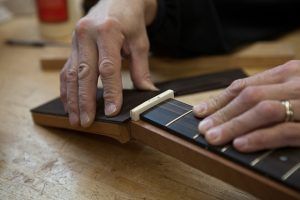
Whether you’re new to playing the acoustic guitar or a seasoned pro, you already know buying the right instrument for you isn’t so simple. Research shows 1.85 million acoustic guitars were sold in the U.S. in 2021, increasing from 1.6 million in 2020. Beyond the sheer volume of guitars to choose from, there are many aspects to consider, from style to neck profile and construction.
The good news is you can start with a few key factors and narrow down the best options and brands. Here’s how to get started.
Body Style

There are several body styles to choose from when it comes to acoustic guitars, each with its own unique tone and feel. The most common acoustic body styles are dreadnought, concert, jumbo, and parlor; you can find them just about anywhere. You’ll also discover specialty models and smaller options, like travel guitars, while searching for the perfect acoustic guitar.
Dreadnoughts
Dreadnoughts are among the most popular acoustic guitar styles, producing a rich and full sound. Featuring a large and broad body, a dreadnought delivers a full tone. Singer-songwriters often choose dreadnought guitars for their power-packed low-end and big sound.
Concert Guitars
Concert guitars are designed for fingerpicking and produce a complex tone. They get drowned out by electric guitars and drums, making them better suited for solo playing. If you gravitate towards a concert guitar and still want to jam out with friends, make sure to check out the sound when you plug it in.
Jumbo Guitars
As the name implies, Jumbo Guitars are larger and longer compared to the more popular dreadnought version. Jumbos also come with a thin waist that makes them appear curvy. Due to the large body, the Jumbo Guitar creates larger volume and is a good choice for strumming away, particularly with country and rock music.
Parlor Guitars
These compact and narrow-waisted guitars are favored by professionals who enjoy the unique sound and beginners for their smaller bodies and shorter scale length, which often make them easier to play. Despite their small size, parlor guitars have a reputation for projecting, especially when amplified. The tone is mid-range and ideal for singers who prefer a mixed voice style.
There’s no right or wrong to picking an acoustic guitar, but you’ll quickly discover different styles are better suited for some players. Smaller players, anyone who wants to command the stage, and guitarists with smaller hands usually gravitate towards concert or parlor guitars. Players with larger physiques are more likely to choose jumbo guitars and parlors for their more delicate, vintage tone.
Tonewoods
The top wood of an acoustic guitar is among the most critical factors in determining its sound quality. The most common top woods are spruce, cedar, and mahogany. Here’s how each wood sounds, plus other options to consider:
- Maple – A heavier, flat-sounding tonewood selected for its ability to produce clear, tonal character and is especially popular for necks and fretboard construction
- Sitka Spruce – A popular sturdy and lightweight wood for acoustic guitar tops with a powerful punch
- Mahogany – An economical, durable choice that’s known for its warm, sustainable sound
- Red Spruce – Pairs well with a steel-string acoustic guitar for its rich tonal quality
- Koa – A dense hardwood with a solid tone that sometimes resembles the sound mahogany creates
- Indian Rosewood – Creates a thick, midrange tonal sound with a reverb
- Brazilian Rosewood – A popular pick for its robust and clear sound
Quality tonewoods matter, but they’re not always the best option, especially if not used with sustainability in mind. Guitar brands have come under fire over the last few decades for not being sustainable or environmentally friendly. When a guitar promises rare, old-growth wood, you’ll pay a premium and could risk buying a guitar with illegally imported wood.
What’s illegal about wood?
Guitar companies must abide by the United Nations Convention on International Trade in Endangered Species of Wild Fauna and Flora, or CITES, which is the organization that works to combat wildlife smuggling. CITES put restrictions on various materials used by instrument makers, although some regulations were lifted a few years later.
However, it’s not just guitar brands that deal with issues sourcing wood with sustainable practices in mind. Any wooden instrument, from violins to bagpipes, often requires permits to complete construction.
Yes, tonewoods matter. But even if a guitar company uses synthetics or less expensive hardwoods, the instrument could still sound good. They may be using alternatives to tonewood due to sustainability issues.
Construction

How a luthier (or guitar maker) puts together an instrument matters as much as the wood. The construction needs to be meticulously accurate to produce just the right sound and hold up to performance standards–even if it’s just for you and your friends. A poorly constructed guitar can sound pretty bad, no matter how well you tune it or try swapping out its strings.
Some guitar brands also skimp on construction by outsourcing to overseas factories or artisans. These artisans may be perfectly capable workers, but don’t necessarily enjoy the same reputation for excellence as a trained luthier. Factory work can also be okay, especially if you want an inexpensive guitar, but it will never sound as good as a handmade guitar.
You’ll also find that not all guitars are made from the same materials. The brand may boast top-quality tonewoods, but that doesn’t mean there aren’t synthetics involved. Guitar brands save money by gluing renowned tonewoods with lesser-quality woods or synthetic materials. These guitars could still sound good, but they don’t reflect the quality and superb sound of a meticulously handmade guitar using top-quality materials.
Cutaway
Whether or not to buy a guitar with a cutaway, or the scooped indentation of the guitar near the neck, is often a matter of style preference. Smaller players often report that a guitar with a deeper cutaway is easier to manage than one without. But for others, a cutaway can make the guitar more comfortable to hold and navigate to the upper fret.
Players with a sharp ear for tonality and sound may notice a guitar without a cutaway sounds fuller while playing in the lower register. However, a cutaway can also impact the sound of an acoustic guitar. In most cases, you’ll never tell the difference when it comes to the sound, but it’s something to consider if you’re meticulous about how your guitar sounds.
Neck Shape
A guitar’s neck shape is also essential in choosing the right instrument, as it can affect playability. Here’s a rundown of different neck shapes and what to expect:
C-Profile Guitar Neck
The most common guitar neck shape is the C-profile. Round and comfortable to hold, they’re often favored by beginners or anyone with smaller hands. Players with larger hands tend to gravitate towards thicker and deeper neck profiles with a more substantial grip.
V-Profile Guitar Neck
If you feel most comfortable resting your thumb on the back of your guitar, you’ll like the V-profile. V-profile guitar necks are usually wider at the nut and taper off as they approach the body of the guitar. Not as standard on modern guitars, you’ll probably see V-necks most frequently on vintage guitars. However, they do hold some similarities to C-shaped necks with a more asymmetrical profile.
U-Profile Guitar Neck
U-shaped guitar necks are suitable for larger hands or if you want to rest your thumb on the back or side of the neck. This neck shape is usually thicker and wider and meets up with the body of the guitar to give it a signature U shape.
D-Profile Guitar Neck
D-profiles are most commonly seen on electric, jazz, and fingerstyle players. Some people also refer to the D-shape as the oval guitar neck. Similar to a “U” shape, this guitar neck narrows towards the heel of the guitar.
Fingerboard Material
The fingerboard is the surface on which you press the strings down to produce notes. The most common materials used for fingerboards are Indian Rosewood and ebony. Rosewood is durable and creates a warm, rich sound, while ebony is denser and produces a brighter, more articulate sound.
Indian Rosewood is also a popular choice for fingerboards due to its ability to produce a warm, soft sound and a natural oiliness that protects against the natural shrinkage of wood. Ebony is a dense wood that delivers a zingy and clean tone when used on a fretboard. It also sounds similar to a maple fingerboard, making it easier to source alternative options.
Tuners
The tuners on an acoustic guitar are responsible for keeping the guitar in tune. Several types of tuners are available, including open gear and sealed gear. Open-gear tuners are the more traditional choice and have a classic look, while sealed gear tuners are more modern and often provide better tuning stability.
The guitar tuner doesn’t have to be made from the most expensive materials, but it needs to be durable. Otherwise, you risk cracks and other damage that can impact how your guitar sounds and holds its tune.
Bridge Material
The bridge is where the strings are anchored to the body of the guitar. The most common materials used for bridges are rosewood and ebony. Rosewood bridges produce a warm, mellow sound, while ebony bridges provide a brighter, more focused sound.
Strings

The traditional steel guitar strings significantly impact how your acoustic will sound, but you can always swap them out and replace them whenever you want. The guitar tone you want will dictate the type of strings you use.
A broad, thick tone requires a heavier string gauge or thickness. Beginners usually gravitate towards a thinner guitar string and a lighter gauge, making pressing down against the frets easier to produce the sound they want. However, if you’re playing a classical guitar, you’ll use nylon strings with a light, mellow sound.
Some guitar brands also offer their own signature strings. For example, Zager Guitars is our ultimate pick because it prioritizes comfort and playability with carbon-coated, pillow-touch strings that are easier to play and still sound incredible. Professional musicians play their guitars, but beginners and those with arthritis or small hands often prefer the brand for its signature touches and custom string placement that make them easier to play.
Brand Name
Let’s talk about brand names and the cool factor. It’s normal for guitar players to want an instrument from a top-name brand and show off their Fender or Taylor. These brands are solid and have built up a sizable following, but that doesn’t mean they’re the best. It just means they produce good guitars. Meanwhile, a brand like Zager Guitars keeps up with the biggest brands out there but is less expensive and more comfortable to play.
An inexpensive, no-name guitar could work fine for your goals. But in an ideal world, you want a guitar from an established brand that’s already proven it produces great-sounding instruments and offers reliable customer service. Don’t choose a guitar based on brand name alone; you should select a company with a good reputation among guitar players.
Electro-Acoustics
If you plan to play your acoustic guitar unplugged most of the time, you need a built-in pickup system to boost your music. But if you want to take the plugged-in, performance route, you need an electro-acoustic package with a good preamp and pickup system. Electro-acoustic guitars from brand-name companies are usually pricey but worth it if you already know that they best suit your musical style and preferences.
Frets
You shouldn’t have to worry too much about the frets on your acoustic guitar. They’re meant to be pressed on and can take some wear and tear. You can get them repaired easily if they’re just uneven or have a few divots. However, if you’re considering buying a cheap or used guitar, make sure it’s not so worn out that the sound quality suffers or creates jagged surfaces.
Guitar Price
Budget always matters when considering what type of acoustic guitar to buy. They can range in price from a few hundred to several thousand dollars. While more expensive guitars usually come with better materials and construction, that’s not always the case.
Some acoustic guitars are incredibly expensive because of their brand name alone or custom hand construction. For example, Greenfield Guitars has a three-year wait list and meticulously handcrafts each instrument to the tune of $19,000. However, a company like Jasmine Guitars offers decent acoustic guitars suitable for beginners and retail for about $150.
Read more about the average acoustic guitar prices here.
Aesthetics
Beyond the instrument’s body style, the overall aesthetics of the acoustic guitar also matter. Some guitars have a darker finisher than others or are designed to look clean and minimalistic. Other acoustics incorporate splashes of color and flair to stand out from the crowd and set your performance apart from the rest. A flashy, fun model should still include all of the essential aspects of a guitar, like the quality of its tonewoods, construction, size, and playability.
So, aesthetics don’t matter much to the sound of an acoustic guitar. However, if you love the way it looks and love playing it, you’re more likely to perform with confidence and enjoy the experience. Just make sure not to compromise on factors like tonewood quality and construction to favor the aesthetic.
Next Steps
The time to figure out what’s important to you when it comes to buying an acoustic guitar isn’t at the store. Take some time to consider what’s most important to you, from sound to quality and aesthetics.
Unless you have an unlimited budget, the price will also play an important factor. Fortunately, most brands, even high-end companies, offer budget-friendly options. Remember that anything cheap will use lower-quality tonewoods and is probably outsourced overseas. If location matters, you can find a list of American-made guitars here or review some of the best acoustic guitars on the market here.
